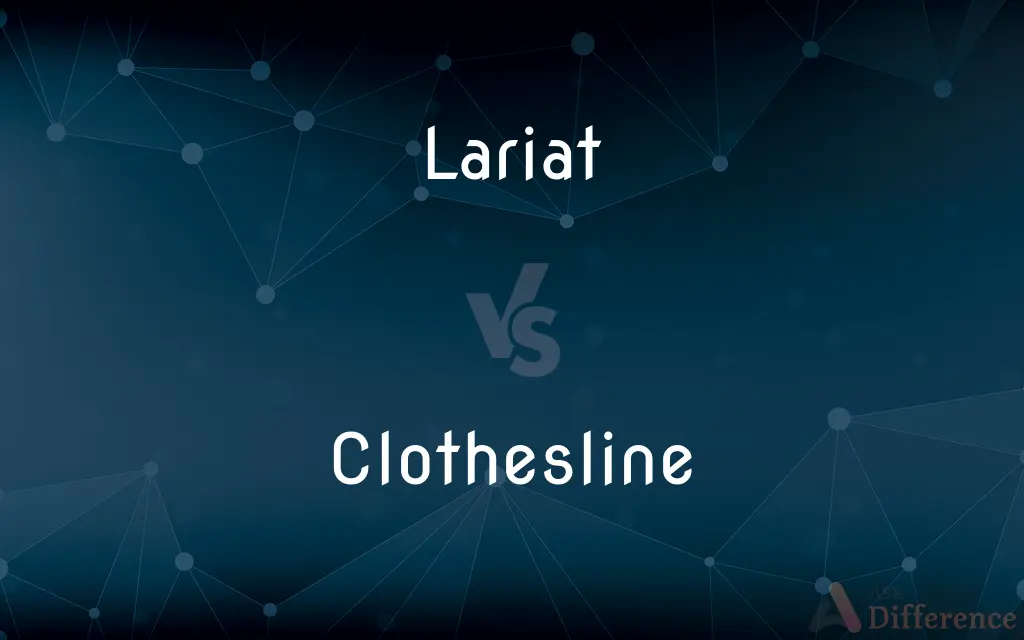Lariat vs. Clothesline — What's the Difference?
Edited by Tayyaba Rehman — By Urooj Arif — Updated on March 31, 2024
A lariat is a type of rope used in roping livestock, while a clothesline is a rope or wire used for hanging laundry to dry.

Difference Between Lariat and Clothesline
Table of Contents
ADVERTISEMENT
Key Differences
A lariat, often used in rodeo events and cattle ranching, is designed for catching livestock by looping around the animal's neck or limbs. It is a tool associated with cowboys and has a specialized design, including a stiffened loop that allows it to be thrown effectively over a distance. On the other hand, a clothesline serves a domestic purpose, providing a space where wet clothes can be hung out to air dry. It is typically made of nylon, cotton, or wire and lacks the specialized features of a lariat.
While the lariat is an essential tool in ranch operations and rodeo sports, symbolizing a certain cultural heritage and skillset related to livestock management, the clothesline represents a practical, eco-friendly approach to drying clothes without relying on electric dryers. This distinction underscores the different roles each plays in their respective settings: one in the world of animal husbandry and the other in household chores.
The technique involved in using a lariat requires skill and practice, as it involves creating a loop that is then thrown to encircle and catch an animal. This technique contrasts with the simplicity of using a clothesline, which involves merely pinning clothes up to dry. The skills associated with a lariat are thus more specialized, while using a clothesline is a more universal and straightforward task.
In terms of materials, lariats are commonly made from materials like hemp, rawhide, or modern synthetic fibers, chosen for their durability and flexibility, which are essential for the quick motions required in roping. Clotheslines, however, can be made from a variety of materials, including those not suited for the outdoors or heavy use, such as thin plastic or cotton, emphasizing their use in a less demanding context.
Despite their different primary functions, both lariats and clotheslines share a basic form—that of a long strand of material. This similarity aside, their purposes, cultural associations, and methods of use place them in entirely different categories of tools and utilities.
ADVERTISEMENT
Comparison Chart
Primary Use
Catching livestock
Hanging clothes to dry
Associated With
Rodeos, cattle ranching
Household chores, eco-friendly living
Material
Hemp, rawhide, synthetic fibers
Nylon, cotton, wire
Skill Required
High (roping skills)
Low (hanging clothes)
Cultural Symbol
Cowboy heritage, rodeo
Domestic life, sustainability
Technique
Throwing a loop to catch livestock
Pinning clothes to dry
Design Features
Stiffened loop for easy throwing
Typically lacks specialized features
Compare with Definitions
Lariat
A rope used in roping cattle and horses, featuring a loop at one end.
The cowboy expertly threw the lariat around the calf's legs.
Clothesline
A rope or wire where laundry is hung to dry.
She hung the wet sheets on the clothesline in the backyard.
Lariat
Requires practice to use effectively.
She practiced with her lariat every day to perfect her throw.
Clothesline
Simple to use, requiring no special skills.
Everyone in the family helps hang clothes on the clothesline.
Lariat
Symbolizes cowboy culture and rodeo sports.
His skill with a lariat won him the roping competition.
Clothesline
Can be made from various materials.
Their clothesline was made of durable nylon to withstand the wind.
Lariat
Associated with livestock management.
Using a lariat is essential for managing cattle on a ranch.
Clothesline
Part of domestic chores.
Hanging laundry on the clothesline is one of his weekly tasks.
Lariat
Made for durability and flexibility.
His new lariat was made of a synthetic fiber for better control.
Clothesline
Represents a traditional method of drying clothes.
Using a clothesline instead of a dryer is more eco-friendly.
Lariat
See lasso.
Clothesline
A cord, rope, or wire on which clothes may be hung to dry or air.
Lariat
A rope for picketing grazing horses or mules.
Clothesline
To knock down (an opponent in an athletic contest) by hooking the neck with an outstretched arm.
Lariat
A lasso.
Clothesline
A rope or cord tied up outdoors to hang clothes on so they can dry.
Hang this towel out on the clothesline for me.
Lariat
A tether.
Clothesline
A structure with multiple cords for the same purpose, such as a Hills hoist.
Lariat
(wrestling) An attack where the wrestler runs towards an opponent, wraps his arm around their upper chest and neck and then forces them to the ground.
Clothesline
The act of knocking a person over by striking his or her upper body or neck with one's arm, as if he or she had run into a low clothesline.
Lariat
(transitive) To lasso.
Clothesline
To knock (a person) over by striking his or her upper body or neck with one's arm, as if he or she had run into a low clothesline.
The referee called a personal foul, when he clotheslined the running back.
Lariat
A long, slender rope made of hemp or strips of hide, esp. one with a noose; - used as a lasso for catching cattle, horses, etc., and for picketing a horse so that he can graze without wandering.
Clothesline
A rope or wire on which clothes are hung to dry.
Lariat
To secure with a lariat fastened to a stake, as a horse or mule for grazing; also, to lasso or catch with a lariat.
Clothesline
A cord on which clothes are hung to dry
Lariat
A long noosed rope used to catch animals
Common Curiosities
How does a clothesline work?
A clothesline works by providing a space where clothes can be hung and pinned to air dry after washing.
What is a lariat?
A lariat is a rope with a loop at one end, used primarily in rodeos and ranching for catching livestock.
What skills are needed to use a lariat?
Using a lariat requires learning roping techniques, which include throwing the loop accurately to catch livestock.
Can a lariat be used as a clothesline?
Technically, a lariat could be used as a makeshift clothesline, but its design and material are optimized for roping, not for hanging laundry.
How do you maintain a clothesline?
Maintenance involves keeping it clean, ensuring it is taut, and replacing it if it becomes worn or damaged to prevent clothes from getting dirty or falling.
Why is using a clothesline considered eco-friendly?
Using a clothesline reduces energy consumption by eliminating the need for an electric dryer, thereby saving energy and reducing utility bills.
Is there a modern equivalent to the lariat in ranching?
While there are various tools and technologies in modern ranching, the lariat remains in use for its effectiveness in specific tasks like calf roping.
Can the sun damage clothes on a clothesline?
Yes, prolonged exposure to direct sunlight can fade colors and weaken fabric fibers, so it's often advised to dry clothes in the shade or during less intense sunlight hours.
Are there different types of clotheslines?
Yes, clotheslines can vary in material, length, and design, ranging from simple ropes to retractable wires and umbrella-shaped stands.
What's the significance of a lariat in cowboy culture?
The lariat is a symbol of cowboy culture and skills, integral to the traditional practices of cattle ranching and rodeo sports.
Share Your Discovery

Previous Comparison
Counterproposal vs. Proposal
Next Comparison
Loonie vs. ToonieAuthor Spotlight
Written by
Urooj ArifUrooj is a skilled content writer at Ask Difference, known for her exceptional ability to simplify complex topics into engaging and informative content. With a passion for research and a flair for clear, concise writing, she consistently delivers articles that resonate with our diverse audience.
Edited by
Tayyaba RehmanTayyaba Rehman is a distinguished writer, currently serving as a primary contributor to askdifference.com. As a researcher in semantics and etymology, Tayyaba's passion for the complexity of languages and their distinctions has found a perfect home on the platform. Tayyaba delves into the intricacies of language, distinguishing between commonly confused words and phrases, thereby providing clarity for readers worldwide.














































